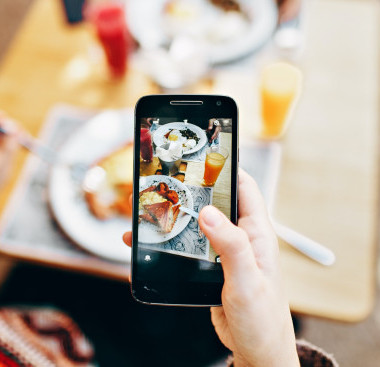Not only have social media platforms become an irrevocable part of everyday life, but they’ve also evolved into a must-have for any food business, and are by far the most effective way to communicate and engage with your customers. What’s the best way of improving your restaurant social media?
Research confirms that it has become standard practice for many potential customers to search for social media profiles when considering where to eat. A whopping 72% of customers check Facebook comments and images in order to make informed decisions about restaurants. Unsurprisingly, the younger generations are especially connected; 99% of Millennials and Gen Z customers are more likely to choose a restaurant based on social media. If you’re already on board but looking to improve your social media skills, these tips will help you maximise your impact.
- Choose the right channels. Your time is precious, and it’s neither necessary nor feasible for restaurant managers and owners to have a presence on every platform. Give some thought to who your main customers are and which channels they’re likely to frequent. Facebook and Instagram are a good place to start, covering a range of demographics between them; Instagram, in particular, is an especially visual medium that’s useful for enticing customers with photos of your food.
- Complete your profiles in full. Customers will use social media for researching your establishment and for getting in touch, and it’s important to ensure they can do both. Ensure you include basic details: opening hours, contact numbers, booking options (Facebook even allows you to add a ‘Book Now’ button if your business takes reservations), menus and a link to your website.
- Keep in touch. Check your messages frequently and respond promptly to avoid frustrating potential customers before they even arrive at your door. This has a significant positive impact on your reputation; over 71% of customers are more likely to recommend a restaurant that responds quickly to their inquiries on social media.
- Post consistently. You don’t need to post every day to make the most of social media, but you do need to ensure that you’re posting consistently enough to keep the attention of your target audience. Avoid leaving your channels stagnant for long periods of time as your audience will lose interest; even posting twice or three times a week can work well as long as you keep it up. Find a pattern that works for you and stick to it.
- Keep it relevant. Consider how to showcase your business without overloading your audience with pushy promotional content. Think about chatting to strangers at a party: you don’t want to dominate the conversation by relentlessly bragging about yourself. The best posts for engagement focus the attention on your followers; you can scatter interesting details about your offering amongst these.
- Timing is everything. Do your research into the best times for posting; timing can make a considerable difference to the impact of your posts. In addition to overall timings, you should also bear in mind the relevance of the content itself to the day and time; a Tuesday morning might not be the optimal time to showcase your cocktail offering.
- Use great photos. When it comes to social media, appearances matter. Ensure the images themselves are good quality and clear — and that any food you feature looks truly delicious. Not only will this boost engagement online, but mouthwatering meals will also go a long way towards attracting people to your restaurant. You don’t have to restrict your photos to just your food; if your venue itself has an enticing ambience or loads of character, then feel free to showcase that too.
- Video is key. Video content continues to generate far more engagement than images or text. This doesn’t necessarily need to be content with a high production value; the ‘stories’ feature, in particular, lends itself to more spontaneous, on-the-go content that can give a look behind the scenes, promote new specials or seasonal items, introduce your employees to add a personal touch or emphasise the provenance of your dishes.
- Capitalise on user-generated content. Any photos, videos, ‘stories,’ reviews or other mentions posted by your customers are social media gold. Because they’re not created by your business, they carry a high degree of credibility, and sharing them to your own page can help build brand advocacy. They’re also a fantastic source of content that you don’t have to create yourself, saving you time and effort.
- Respond to reviews. Reviews are a valuable source of information, giving you an objective perspective on your strengths and weaknesses and allowing you the opportunity to improve where necessary. Whether a review is positive or negative, it’s crucial to respond as quickly as possible. In fact, dealing with a negative review in a swift and apologetic manner — and offering appropriate compensation where needed — may even end up counting in your favour, as other potential customers can see that you are dedicated to offering great service even when things go awry.
- Run competitions. While you want your content itself to be attractive enough to generate organic traffic, there’s nothing quite like a competition to get people engaging with your page. Use social media competitions sporadically to gain likes and boost engagement, giving away prizes such as vouchers or a dinner for two.
For more expert advice and support for your hospitality business, visit www.tenkites.com or follow us on social media.
